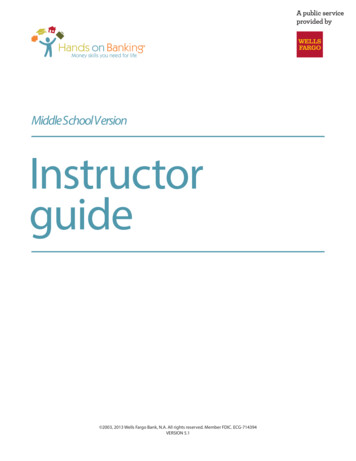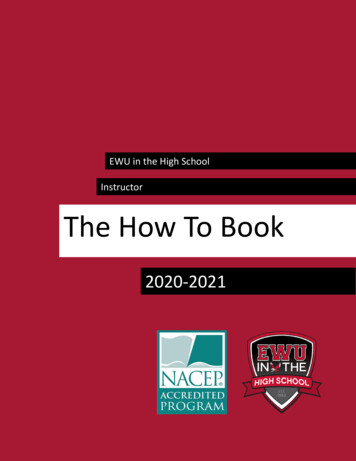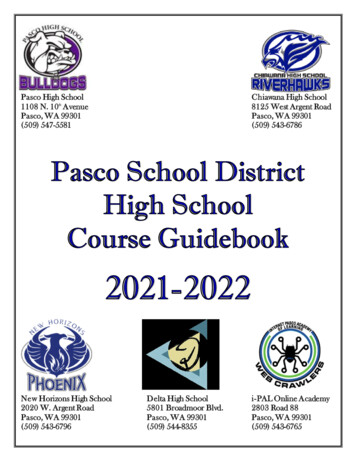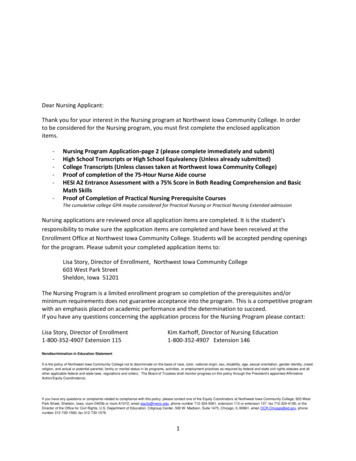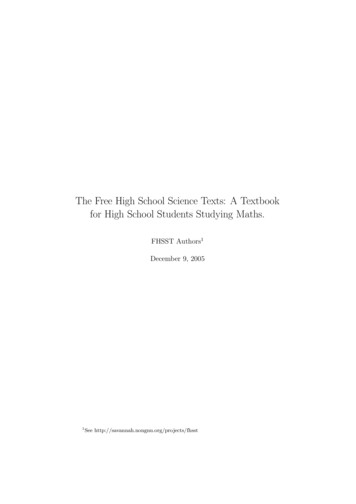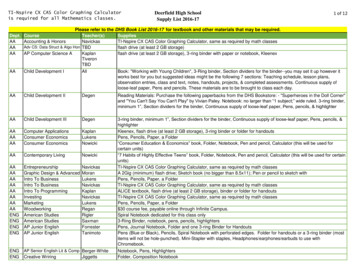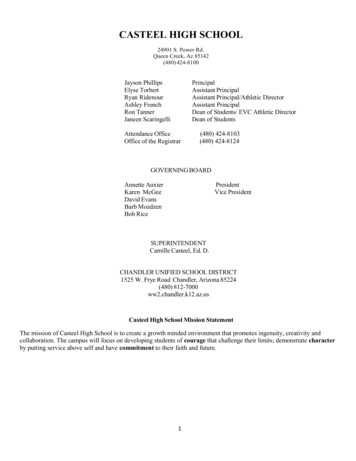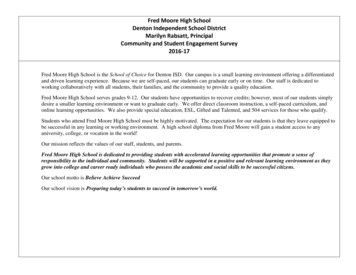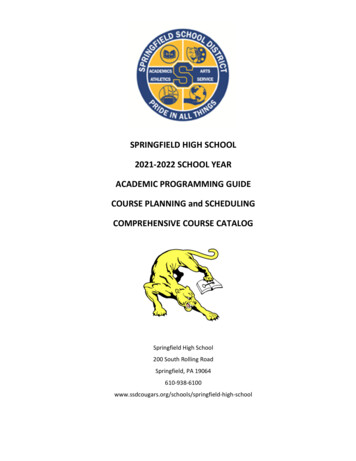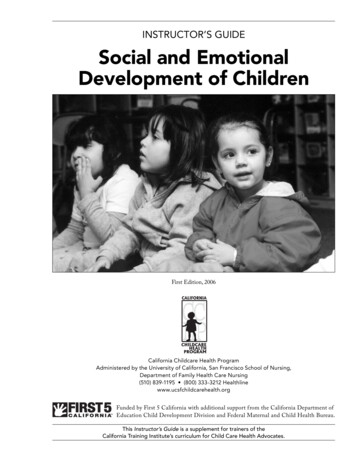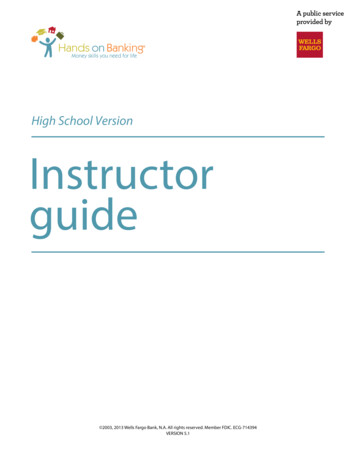
Transcription
High School VersionInstructorguide 2003, 2013 Wells Fargo Bank, N.A. All rights reserved. Member FDIC. ECG-714394VERSION 5.1
Welcome to Wells Fargo’s Hands on Banking program!This fun, interactive, and engaging financial education program is designed for both self-paced, individual learning andclassroom use. These Instructor Guides are designed to help you share this valuable program with groups of any size.In these guides, you’ll find everything you need to lead participants through real-life scenarios, group discussions,and activities that will encourage them to apply these lessons to their daily lives.By sharing the Hands on Banking program with others, you’ll help them to take control of their finances and build abrighter financial future.Program Overview.The Hands on Banking program covers all the basics of smart money management. The curriculum is designed forfour age groups: Adults, Young Adults (ages 15–21) Teens (grades 6–8) and Kids (grades 4 and 5).The Hands on Banking program is an easy and enjoyable way to teach and learn the essentials of financial education:the basics of bank services, the importance of saving, smart money management, using credit responsibly, invest ing, wealth building, and more. Whether it’s opening a checking account, avoiding identity theft, paying for college,applying for a credit card, or starting a small business, the Hands on Banking program provides real-world skills andknowledge everyone can use.Educational Standards.It’s easy to integrate the Hands on Banking program into the classroom: the lessons for school-aged students arealigned with national and state educational standards for economics, financial literacy, mathematics, and Englishlanguage arts.The segments in this program adhere to the following economics, financial literacy, mathematics, and English lan guage arts standards: National Council of Economic Education, the National Association of Economics Educators, andthe Foundation for Teaching Economics, Voluntary National Content Standards in Economics(1997). For details, see www.fte.org. JumpStart Coalition for Personal Financial Literacy, National Standards in K-12 Personal FinanceEducation (2007). For details, see www.jumpstartcoalition.org. National Council of Teachers of Mathematics, Principles and Standards for School Mathematics(2000), Grades 9-12. For details, see www.standards.nctm.org. The National Council of Teachers of English (NCTE) and International Reading Association (IRA),Standards for the English Language Arts (1996); Grades K-12. For details, see www.ncte.org. National Governors Association Center for Best Practices and Council of Chief State SchoolOfficers (2010) For details see www.corestandards.org/HANDS ON BANKING INSTRUCTOR GUIDE YOUNG ADULTS VERSION 5.1 2003, 2013 Wells Fargo Bank, N.A. All rights reserved. Member FDIC www.handsonbanking.orgPage i of iii
Using the Instructor Guides.The Instructor Guides can be used alone or as an adjunct to the online/CD-ROM program; however, we stronglyencourage you to review the program online or request a free CD-ROM. Even if participants will not experience theprogram online, gaining familiarity with the online program will help you present it more effectively. The online pro gram includes simulations, calculators and an extensive resource library to help supplement these guides—pleasetake advantage of all these great resources.Each topic in the Hands on Banking program has its own Instructor Guide which follows the organization of theonline program and includes much of the same content. The High School Version of the Hands on Banking programincludes six topics:1.Getting Started.2.Earning .3.Spending Smart.4.Save, Invest & Build Wealth.5.All About Credit.6.School & .Each Instructor Guide includes: A glossary of all the relevant terms introduced in the topic. A lesson introduction which includes:ºAn overview.ºLearning objectives.ºSample discussion questions to start the lesson.º“The Basics”—a list of bullet points outlining the key concepts of the lesson. A lesson summary of all the key concepts of the lesson. Activities, quizzes, discussion questions, handouts and important tips for key concepts. A topic summary that lists all the major concepts of the topic. Additional activities designed to extend the concepts presented in the topic to the real world. A Library Resource section that includes additional reference materials and handouts.The instructions for organizing your group for activities are recommendations only. You know what will work bestwhen it comes to teaching and engaging your group.HANDS ON BANKING INSTRUCTOR GUIDE YOUNG ADULTS VERSION 5.1 2003, 2013 Wells Fargo Bank, N.A. All rights reserved. Member FDIC www.handsonbanking.orgPage ii of iii
Lesson Concepts and Icons.Each lesson of a topic will present several key concepts. These concepts are introduced to your participants in a varietyof ways which are represented in the guides by these icons.Activity.An activity usually involves some sort of class participation, whether it is a matching game, a fill inthe blank exercise, or worksheet completion. Typically after an activity you will have the opportunityto lead a discussion.Discussion.Discussions allow you to introduce key concepts while involving your participants in the conversa tion and making the information relevant to them. In some places, sample discussion questions areincluded to help you guide the discussion.Quiz.Throughout all the topics, there are short quizzes designed to start discussions or quickly test partici pants’ knowledge of certain concepts.Handout.All of the Instructor Guides include handouts that are designed as a resource for your participantsto use outside the classroom in their daily lives. For example, one handout includes a list of web linksfor participants to use as they start, grow and manage their small business.Activity and Discussion Handouts.Sometimes during a lesson, an activity or discussion will also use a handout to teach key concepts. Inthese cases the Handout icon is placed below the Activity or Discussion icon.Transition.The Transition icon will let you know when the next concept is related to or follows up on the con cept you’re presently discussing or covering with your participants.Library Articles.The online/CD-ROM version of the Hands on Banking program includes a vast library with relevantarticles, checklists, and worksheets for each topic and lesson.Relevant library articles are recommended at the end of each lesson. These articles provide additional informationto use in teaching key concepts (look for the library icon as seen above). We encourage you to review the full libraryselection online or on the CD-ROM. Feel free to enrich your sessions with additional articles from the library.You can photocopy these articles and distribute them to participants to start a discussion, or you may want to givethem away as handouts for participants to read on their on time. These library articles expand the topic content.HANDS ON BANKING INSTRUCTOR GUIDE YOUNG ADULTS VERSION 5.1 2003, 2013 Wells Fargo Bank, N.A. All rights reserved. Member FDIC www.handsonbanking.orgPage iii of iii
Pre-and Post-tests for Adults and Young Adults.When you use the Adults’ and/or Young Adults’ courses with a group or in a classroom setting, we invite you to usethe Hands on Banking pre and post test we’ve developed. They can be accessed in the “Instructional Resources”section of handsonbanking.org. The Pre-test will help you to determine what topics to emphasis with your group. The Post-test will help you assess participants progress.We’d like to request that you report the anonymous results of these tests to our Hands on Banking team. Your inputwill help us to continue to improve the program.How to Access the Interactive Program.The Hands on Banking program is available free of charge in both English and Spanish. On the Web at www.handsonbanking.org and www.elfuturoentusmanos.org. Available for free on CD-ROM—all four age groups are included. You may order a CD at HOBCD@wellsfargo.com. There is no charge for small quantities ofthe CD-ROM. Please email for information regarding high-volume requests. Allow two weeksfor delivery.Once again, Thank You!Thank you for sharing these valuable financial education programs with students and adults in our communities.As an instructor, your training and guidance will provide others with the knowledge and skills they need for abrighter financial future.We welcome your comments and suggestions for future versions of the Hands on Banking curriculum and theInstructor Guides. And, we would very much like to hear your success stories. Please contact us via email atHOBinfo@wellsfargo.com.The Hands on Banking program is sponsored and developed by Wells Fargo to serve our communities. The productsand services mentioned are those typically offered by financial institutions and do not represent the specific termsand conditions of Wells Fargo’s products and services. The site contains no advertising and does not require or collectany personal information.HANDS ON BANKING INSTRUCTOR GUIDE YOUNG ADULTS VERSION 5.1 2003, 2013 Wells Fargo Bank, N.A. All rights reserved. Member FDIC www.handsonbanking.orgPage iv of iii
Topic 1 — Getting StartedTopic Overview.This topic teaches participants how to get started with money management. From understanding how money works,to creating a money toolkit, to uncovering tips for keeping track of their finances, participants understand how goodmoney management holds the key for lots of good times ahead.This topic has seven lessons:1.You & .2.So what do you want?.3.How Money Works.4.Your Money Toolkit.5.Learn “How-To ”.6.Keep Track.7.Stay Safe.These lessons include a number of hands-on participant activities. Use these activities to help simulate real-worldscenarios and activities with your participants.This instructor guide is based on and follows the structure of the online Hands on Banking program. We invite you touse and experience the online program as it is an excellent resource that will support your instructional efforts andenhance your participants’ experience. It includes a variety of interactive lessons and many helpful resource libraryarticles to augment this guide. Visit www.handsonbanking.org to access the program. Should you require a CD ROM to access the program you may request a free copy at HOBCD@wellsfargo.com.HANDS ON BANKING INSTRUCTOR GUIDE YOUNG ADULTS GETTING STARTED VERSION 5.1 2003, 2013 Wells Fargo Bank, N.A. All rights reserved. Member FDIC www.handsonbanking.orgPage 1 of 90
Topic 1 — Getting StartedInstructor’s Guide — Young Adults.Table of Contents.Topic Overview1.Glossary4.Lesson 1: You and 8.Your Money IQ (Instructor Copy)Lesson SummaryLesson 2: So What Do You Want?9.10.11.Eric Needs a Plan (Instructor Copy)12.Choose Your Dreams (Instructor Copy)14.Lesson Summary17.Lesson 3: How Money Works18.Money Defined (Instructor Copy)19.Lesson Summary21.Lesson 4: Your Money Toolkit22.Take it to the Bank! (Instructor Copy)23.Savings and Checking Accounts (Instructor Copy)25.More Money Tools For You (Instructor Copy)27.Lesson Summary30.Lesson 5: Learn “How-To ”31.How to Open a Savings or Checking Account (Instructor Copy)32.How to Fill in a Deposit Slip (Instructor Copy)34.The Parts of a Check (Instructor Copy)36.How to Write a Check (Instructor Copy)38.How to Endorse a Check Activity (Instructor Copy)40.The Parts of a Debit Card Activity (Instructor Copy)42.How to Use an ATM (Instructor Copy)44.Practice your ATM Skills (Instructor Copy)47.Lesson Summary49.HANDS ON BANKING INSTRUCTOR GUIDE YOUNG ADULTS GETTING STARTED VERSION 5.1 2003, 2013 Wells Fargo Bank, N.A. All rights reserved. Member FDIC www.handsonbanking.orgPage 2 of 90
Topic 1 — Getting StartedInstructor’s Guide—Young Adults.Table of Contents.Lesson 6: Keep Track50.Keys to Keeping Track (Instructor Copy)51.How to Use Your Transaction Register Activity (Instructor Copy)53.How to Read Your Statement Activity (Instructor Copy)55.How to Reconcile Your Account Activity (Instructor Copy)57.Avoid Overdrafts! (Instructor Copy)59.Overdrafts Quiz (Instructor Copy)60.Mackenzie at the Mall (Instructor Copy)61.Lesson Summary63.Lesson 7: Stay Safe64.Security at Home and Online (Instructor Copy)65.Scenario Activity—An Urgent Email (Instructor Copy)66.Lesson Summary69.Topic Summary70.Test Yourself (Instructor Copy)71.Appendix73.HANDS ON BANKING INSTRUCTOR GUIDE YOUNG ADULTS GETTING STARTED VERSION 5.1 2003, 2013 Wells Fargo Bank, N.A. All rights reserved. Member FDIC www.handsonbanking.orgPage 3 of 90
Topic 1 — Getting StartedGlossary.Instructor note:The Glossary contains definitions and descriptions of valuable terms and phrases related to this topic. Encourage your par ticipants to use the Glossary during and after the class to become more familiar and comfortable with the terminology.Photocopy the glossary on the next page and hand it out to your participants.HANDS ON BANKING INSTRUCTOR GUIDE YOUNG ADULTS GETTING STARTED VERSION 5.1 2003, 2013 Wells Fargo Bank, N.A. All rights reserved. Member FDIC www.handsonbanking.orgPage 4 of 90
Topic 1 — Getting StartedGlossary.Account.A banking service allowing a customer’s money to be handled and tracked. Commonbank accounts are savings and checking accounts.Appreciation.The amount of value an item such as a car, home or stock, gains over time from the origi nal purchase price.Asset.Anything of value owned by a person or company. For example, a person’s assets mightinclude cash, a house, a car, and stocks. A business’s assets might include cash, equip ment, and inventory.Automated TellerMachine (ATM).A specialized computer used by bank customers to manage their money, for example, toget cash, make deposits, or transfer money between accounts.Available balance.The amount of money in your account that you can use or withdraw. Your available bal ance may not reflect all transactions that you have made, for example checks you havewritten that have not yet been paid from your account.Bad or bounced check.(see Non-sufficient funds).Bank.A financial institution that handles money, including keeping it for saving or commercialpurposes, and exchanging, investing, and supplying it for loans.Check.A written order instructing the bank to pay a specific amount of money to a specific per son or entity. The check must contain a date, payee (person, company, or organization tobe paid), amount, and an authorized signature.Checking account.A bank account that allows a customer to deposit and withdraw money and writechecks. Using a checking account can be safer and more convenient than handling cash.Clear.When the bank pays a check you have written and then subtracts the amount from youraccount, your check has “cleared” the bank.Credit Union.A non-profit financial institution that is owned and operated entirely by its members.Credit unions provide financial services for their members, including savings and lend ing. Large organizations may organize credit unions for their members, and some com panies establish credit unions for their employees. To join a credit union, a person mustordinarily belong to a participating organization, such as a college alumni association orlabor union. When a person deposits money in a credit union, he or she becomes a mem ber of the union because the deposit is considered partial ownership in the credit union.Debit card.A card linked to a checking account that can be used to withdraw money and makedeposits at an ATM and to make purchases at merchants. When you use a debit card, themoney will be deducted from the linked checking account.Depreciation.A loss of value in real property brought about by age, physical deterioration, functionalor economic obsolescence.Endorse.To sign the back of a check, authorizing the check to be exchanged for cash or credit.HANDS ON BANKING INSTRUCTOR GUIDE YOUNG ADULTS GETTING STARTED VERSION 5.1 2003, 2013 Wells Fargo Bank, N.A. All rights reserved. Member FDIC www.handsonbanking.orgPage 5 of 90
Topic 1 — Getting StartedGlossary.Federal DepositInsurance Corporation(FDIC).An independent agency of the United States government that protects customers fromthe loss of their deposits if an FDIC insured financial institution fails. The basic insuranceamount is specified per depositor per insured financial institution. Certain retirementaccounts, such as Individual Retirement Accounts, are insured up to specified amountper depositor per insured financial institution. Customers can increase the amount ofmoney insured at any one financial institution by owning deposit accounts in differentownership categories (e.g., Individual Accounts, Retirement Accounts, Joint Accounts,Revocable Trust Accounts). Please visit www.fdic.gov for the most current deposit insur ance amounts.Financial institution.Companies such as banks, credit unions, and savings institutions that provide a widerange of money management products and services to consumers. Financial institutionscollect funds from the public and place them in financial assets, such as deposits, loans,and bonds.Inflation.An increase in the general price level of goods and services; a decrease in the purchasingpower of the dollar.Interest.The amount of money paid by a borrower to a lender in exchange for the use of thelender’s money for a certain period of time. For example, you earn interest from a bank ifyou have a savings account and you pay interest to a lender if you have a loan.Liabilities.The amount of money an individual or business owes to someone else: a debt.Line of credit.An arrangement by which a lender extends a specific amount of credit to a borrowerfor a certain time period. As long as the borrower repays the principal with interest, heor she can continue to borrow against the line of credit during the agreed upon timeperiod. A line of credit can be unsecured or secured. Also called a credit line.Money order.A document issued by a post office, bank, or convenience store ordering payment of aspecific sum of money to an individual or business. There is generally a small charge forpurchasing a money order.Non-sufficient funds(NSF).The lack of enough money in an account to pay a particular check or payment. Alsoknown as insufficient funds. A check with insufficient funds may be returned unpaid tothe person cashing it. This has a negative impact on the check writer’s history of handlinghis or her account, and may prevent opening of future accounts. See also Overdraft.Overdraft.When there is not enough money in an account to cover a transaction and the bank paysit on your behalf, creating a negative balance in the account that you need to repay.Overdraft Protection.Offered by many banks, overdraft protection is a service that automatically transfersmoney from a linked account that you select, such as a savings or credit account, whenyou don’t have enough money in your checking account to pay your transactions.Payee.The person, company, or organization to whom a check is written: a person or companywho is to receive money.HANDS ON BANKING INSTRUCTOR GUIDE YOUNG ADULTS GETTING STARTED VERSION 5.1 2003, 2013 Wells Fargo Bank, N.A. All rights reserved. Member FDIC www.handsonbanking.orgPage 6 of 90
Topic 1 — Getting StartedGlossary.Phishing.Is usually a two-part scam involving email and spoof websites. Fraudsters, also known asphishers, send email to a wide audience that appears to come from a reputable companyrequesting personal information accounts numbers. This is known as a phish email.Reconcile.The process used to determine if the balance in your account register matches the balancereported by the bank on your account statement. Also called balancing your account.Returned item.This is also known as “non-sufficient funds” or a “bounced check.” If you spend moremoney than you have in
Hands on Banking program covers all the basics of smart money management. The curriculum is designed for four age groups: Adults, Young Adults (ages 15–21) Teens (grades 6–8) and Kids (grades 4 and 5). The Hands on Banking program is an easy and enjoyable way
